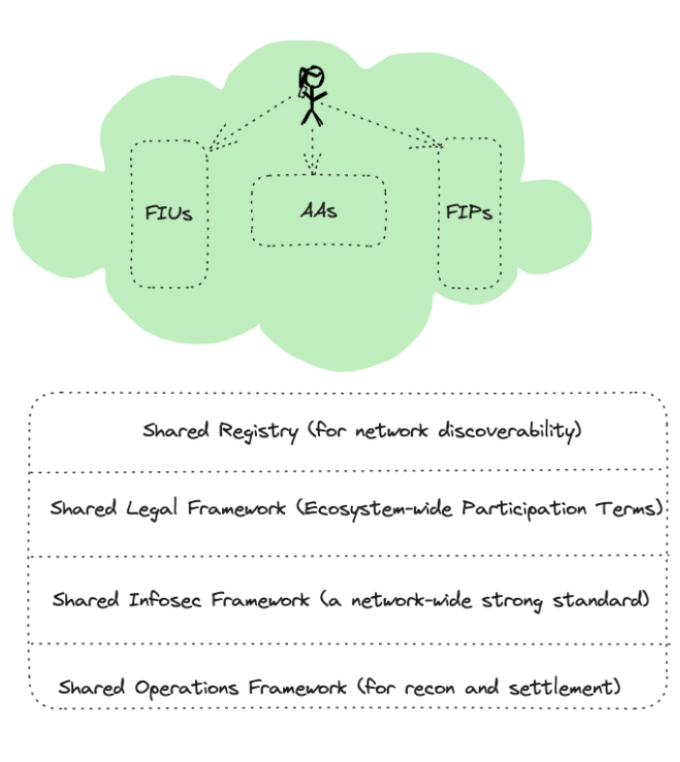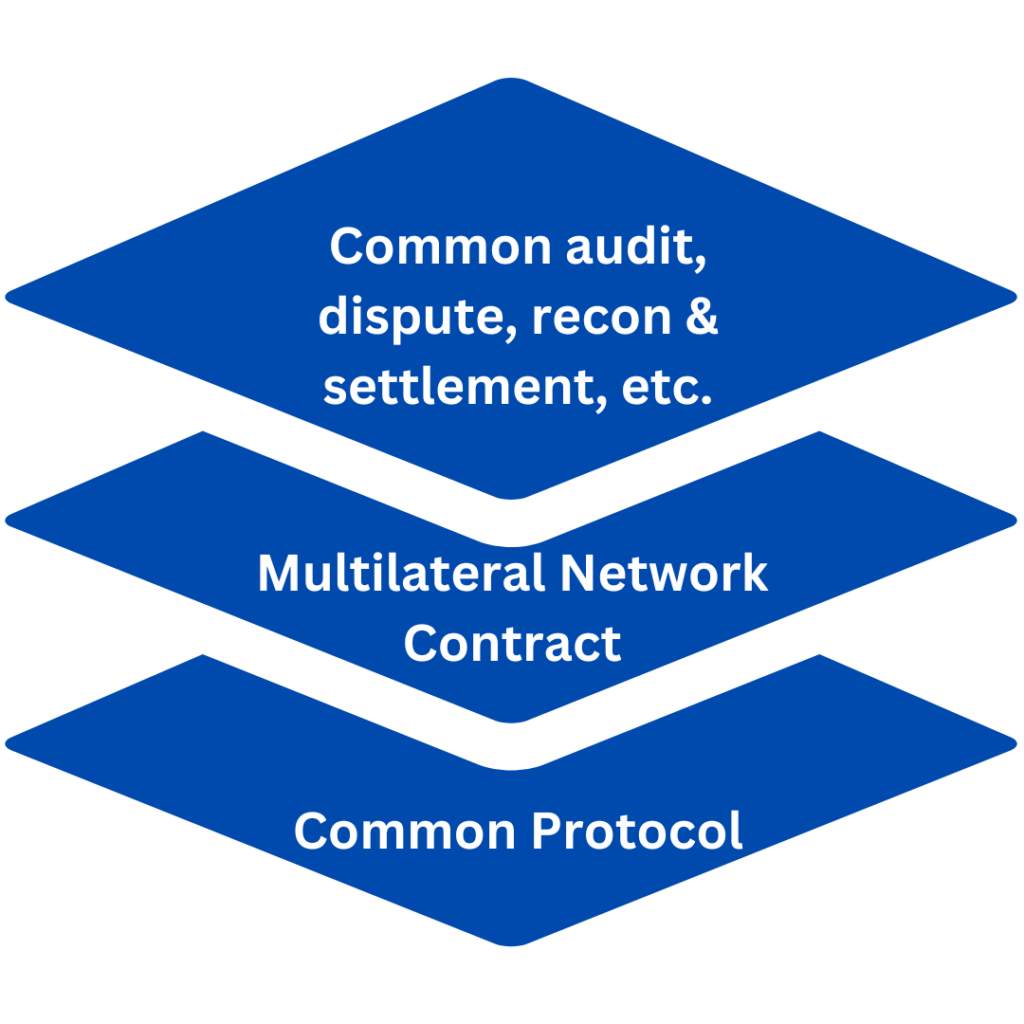Scaling Open Networks Open House
Last week, Sahamati hosted an open house, “Scaling Open Networks,” bringing together stakeholders to explore the realms of interoperable protocols and trust procedures. The open house aimed to foster dialogue and insights into enhancing the scalability and trustworthiness of open networks. Read further to know how the AA Network can usher trust, interoperability, and scalability.
Key Design Principles of Open Networks – Dr. Pramod Varma
Trends in Computing and Digitization
The history of computing and digitization has evolved from mainframes to branch-based workflow digitization to gradually integrating customers into the digital landscape. As networks emerged, it kicked in the notion of computers acting as databases, application servers, etc. The internet emerged as interconnected global servers through standardized protocols, creating a Network of Networks. Consumer digitization brought self-service kiosks, ATMs, and Internet banking. The critical upcoming trends are the proliferation of smartphones and connectivity, ensuring near-universal access to computing devices, and the interfaces shifting toward human-centric interaction through touch, sound, and voice, enhancing accessibility and inclusivity. This highlights the relentless progression toward a more connected, user-friendly, and digitally empowered world.
Unbundling of Transaction Chain
The transaction chain has been unbundling from the periphery to the core. At Level 3, regulated entities have played a pivotal role, followed by Level 2’s focus on Fintechs driving innovation to enhance experiences, convenience, and value-addition. Level 1 centers on individual empowerment through natural interfaces at a population scale. This unbundling mirrors the democratization of access to computing devices, creating a synergistic evolution. A forthcoming trend is the emergence of Internet-like, decentralized, Peer-to-Peer transaction enablement facilitated by well-defined protocols. This shift aims to curtail the costs associated with trust, onboarding, and processing, fostering inclusion on a population scale.

From Bilateral Trust to Network Trust
Key to network thinking is Network Trust, replacing bilateral with multilateral interactions fostering end-to-end trust in business transactions, facilitated by the symbiosis of Technology and Governance for seamless interoperability. While technical interoperability is readily attainable through shared protocols, the legal, contractual, and grievance redressal interoperability is complex. Ultimately, the goal is comprehensive end-to-end trust, amalgamating Technology, Network Contracts, and mutual trust, establishing a collaborative network foundation.


Architect AA Network Trust
The primary objective is to introduce a “Network-Trust model” within the AA framework. Technical interoperability is already established in the network, but a shared, network-wide enhancement and alignment of legal, information security, and operational aspects are imperative. This necessitates the backing of a network facilitator to oversee and enable this convergence, which requires the participation and support of all network members.
Strengthening Network-level Trust Procedures in AA
Ensuring a shared, network-wide enhancement and alignment of legal, information security, and operational aspects is crucial. While the AA Network may have addressed issues from a technological perspective, it’s essential to tackle this challenge from the business, commercial, and ecosystem angles. Establishing mechanisms for trust spanning legal, commercial, and information security domains is paramount in this effort. By weaving these threads together, the facilitator can cultivate a comprehensive and robust foundation of trust across all network dimensions.
Ramgopal Subramani, the Chief Strategy Officer at Perfios, commended that the AA ecosystem has pioneered a well-defined and effectively implemented interoperability. However, the solution is primarily technological rather than commercial or business. It’s imperative to engage the entire ecosystem in shaping operational aspects by mainstreaming checks and balances. Creating awareness through FAQs and handbooks fosters trust. Establishing network-level agreements such as the participation terms (PT) is essential, but at the same time, the ecosystem must address the legal, information security, and commercial dimensions holistically.
The network-level agreement, participation terms (PT), was applauded by Nilanjan Sinha, General Counsel, ICICI Bank, as a legal agreement meticulously designed to uphold fairness, balance, and neutrality, ensuring uniformity by having all parties sign identical terms transcending industry-specific boundaries. He acknowledged that showcasing the participation terms (PT) on the website is remarkable as a commitment to openness, building a solid foundation of trust within the ecosystem.
He suggested that spreading awareness of the value proposition of interoperability to consumer choice is paramount. Awareness entails comprehensively explaining concepts, roles, and responsibilities to all stakeholders. Simultaneously, involving customers in these conversations is pivotal, as their engagement can catalyze a collective push for interoperability. Encouraging consumers to participate by signing the participation terms (PT) can amplify the momentum toward creating a more interconnected and inclusive ecosystem.
Madhav Bhadra, CEO of AQM Technologies Pvt Ltd, iterated that trust is the cornerstone solidified by satisfying information security needs. The transition from bilateral to network trust by systematically addressing key infosec components involves establishing trust in interfaces and implementing effective governance practices aligning with compliance standards. He suggested building trust through common reporting practices to foster transparent governance. Further, adopting code of conduct practices, community-sourced models, a singular source of evidence, and alignment with governance and regulatory frameworks converge to lay the groundwork for a secure, well-regulated ecosystem that inherently cultivates trust.
Bertram D’souza, CPIO at Protean and CEO at ProteanAA, suggested measures across various topics. He proposed forming reconciliation and settlement providers (RSPs) akin to the ONDC network to eliminate the manual procedural and legal complexities of commercial reconciliation and settlement. On the commercial model for the network, he iterated that the fee structure should avoid bilateral fees or interchanges, enhancing fairness. The process should be operationalized as a community-driven endeavor, focusing on technical aspects and procedural efficiencies. Also, standardizing commercial contracts will simplify operations and reinforce consistency. He emphasized that sustaining explicit transparent operations will inherently build implicit trust, a critical factor for achieving true interoperability.